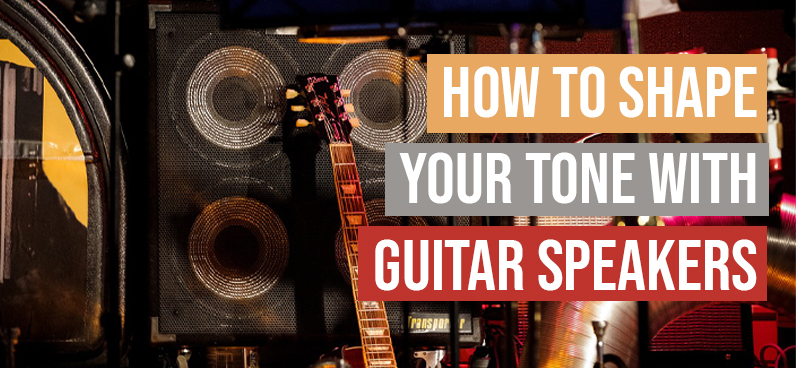
By: Will Soprano from the MojoTone Speaker Shop
This is not one of those “here’s the best speaker” articles. You could care less. You’re after tone, and so are we. Who do you want to sound like? Or maybe what do you want to sound like? From Americana to British Metal, from clean to crunch.
Pickups may be your first mod, but speakers are not far behind. We’re going to look at speaker combinations, speaker pairings, and pairing pickups with speakers to shape your tone.
How to Shape Your Tone with Guitar Speakers
Some speakers are designed to have a lot of head room. On the opposite end of the spectrum some are designed to break up and distort. There’s no right answer here, and both American Voicing and British Voicing require some amount of volume within the cabinet or combo amp.
Moving onto the amp, choosing a ceramic or alnico speaker will further shape your tone. Generally speaking, ceramic speakers and their magnets produce a brighter sound, while alnico speakers bring a warmer sound.
American Voicing Guitar Speakers
Smooth but bright, American speakers are characterized by countless recordings of classic Fender amplifiers recorded by 60’s surf bands and more modern Americana bands like Wilco or Tom Petty.
British Voicing Guitar Speakers
For the more aggressive guitarist, with a proportionately aggressive top-end roll off that helps them handle heavily distorted sounds. These are symbolized by an emphasis on higher frequencies a bit more than American voiced speakers. Think British metal or earlier influences like Jimi Hendrix and Cream.
Guitar Cabinet Speaker Combinations
There’s a good bit of mysticism over speaker combinations within cabinets. The major difference boils down to this: volume and distortion. While distortion originates in the amp, British Voiced speakers typically handle distortion better than American Voiced speakers, and using or changing your speaker to a British voiced speaker will lead to better sounding distortion.
In the end, the Amp is creating the distortion - and while British speakers are best for this sound, that doesn’t mean that you can’t distort an American Voiced speaker - Keep in mind that, an American Voiced Speaker may sound harsh when pushed to the point of distortion.
Otherwise, volume is another added benefit from more speakers in a cabinet vs a single speaker cab. Multiple speakers will push more air than a single speaker. That being said, you can play with speaker combinations within the cabinet in your journey to achieve more particular sounds. By speaker combinations I’m referring to mixing speaker types within the same cabinet - like this ?
Mixing Speakers Within Guitar Cabinets
We’ve talked at length about American and British Voicing speakers and their differences. MojoTone has added to that conversation. The Greyhound Speaker Series, aptly named for its utility between the two aforementioned speakers. As you push to dial in your amplifier sound, whether using a lot of distortion or a little distortion, the Greyhound Series will help you get there.
Guitar Pickups and Speaker Combinations
From John Mayer to Jimmy Page you’ll find pairings in their pickups and speakers. Humbuckers are traditionally found in setups made for heavier music, darker tones sounds and speaker breakup through sealed 4x12’s. While single coils paired with the American voiced speakers bring the brighter / cleaner sounds with less distortion, playing through Fender style combos that are open back. This is of course not always the case but more of a generalization.
Two popular guitar pickup / speaker combinations:
Humbuckers and a Les Paul paired with a Marshall stack + British Vintage speaker.
Single coil pickups and a Stratocaster played through a Fender deluxe reverb + Anthem speakers.
Open vs Closed Back Guitar Cabinets
One of the single biggest tone factors for speakers is whether the back of the cab is open or closed. You’ll see a difference in fullness, realism, and blending. Basically, you can have one speaker bring two different experiences depending on whether the back of the cab is open or closed.
Here’s the breakdown:
Closed Back Guitar Cabinets
The speaker will resonate a full, almost gut thumping feeling with fuller lows and slightly attenuated highs. You’ll gain more directional sound projection as the cone moves, leaving little lost through the rear. Closed back cabinets will inherently be less efficient - which means less volume for the same power. However they can allow for a more even response, but this depends on speaker choice - tuning and use of ports.
Open Back Guitar Cabinets
A more surrounding sound (less focused) effect is the first thing you’ll notice with the back open. The escaping sound waves from the back blend with those in the front in reverse-phase. That means you’re actually producing the tone from the rear of the cone to tame any low-end boominess (or woofiness) the closed cab may produce.
How Are You Shaping Your Tone?
I’d love to hear what you’re tweaking in your journey through tone. What sounds are you after, or who are you replicating? What techniques have you tried already? Maybe you’ve lowered your pickups or maybe now you’re looking at the headroom in your amp. Looking forward to your next breakthrough in tone!